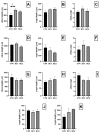Intestine Health and Barrier Function in Fattening Rabbits Fed Bovine Colostrum
- PMID: 37999480
- PMCID: PMC10675739
- DOI: 10.3390/vetsci10110657
Intestine Health and Barrier Function in Fattening Rabbits Fed Bovine Colostrum
Abstract
The permeability of the immature intestine is higher in newborns than in adults; a damaged gut barrier in young animals increases the susceptibility to digestive and infectious diseases later in life. It is therefore of major importance to avoid impairment of the intestinal barrier, specifically in a delicate phase of development, such as weaning. This study aimed to evaluate the effects of bovine colostrum supplementation on the intestinal barrier, such as the intestinal morphology and proliferation level and tight junctions expression (zonulin) and enteric nervous system (ENS) inflammation status (through the expression of PGP9.5 and GFAP) in fattening rabbits. Rabbits of 35 days of age were randomly divided into three groups (n = 13) based on the dietary administration: commercial feed (control group, CTR) and commercial feed supplemented with 2.5% and 5% bovine colostrum (BC1 and BC2 groups, respectively). Rabbits receiving the BC1 diet showed a tendency to have better duodenum morphology and higher proliferation rates (p < 0.001) than the control group. An evaluation of the zonulin expression showed that it was higher in the BC2 group, suggesting increased permeability, which was partially confirmed by the expression of GFAP. Our results suggest that adding 2.5% BC into the diet could be a good compromise between intestinal morphology and permeability, since rabbits fed the highest inclusion level of BC showed signs of higher intestinal permeability.
Keywords: bovine colostrum; enteric nervous system; intestinal barrier; intestinal health; rabbits; zonulin.
Conflict of interest statement
The authors declare no conflict of interest.
Figures








References
-
- Gidenne T., Fortun-Lamothe L. Feeding Strategy for Young Rabbits around Weaning: A Review of Digestive Capacity and Nutritional Needs. Anim. Sci. 2002;75:169–184. doi: 10.1017/S1357729800052942. - DOI
-
- Oglesbee B.L., Lord B. Gastrointestinal Diseases of Rabbits. Ferrets Rabbit. Rodents. 2020:174–187. doi: 10.1016/B978-0-323-48435-0.00014-9. - DOI
Grants and funding
LinkOut - more resources
Full Text Sources
Miscellaneous

